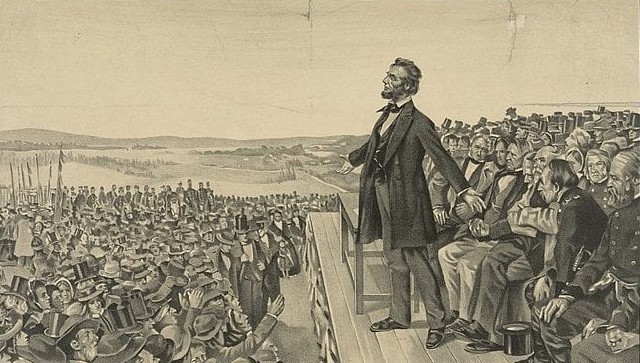
An artist’s rendering of President Abraham Lincoln delivering the Gettysburg Address on Nov. 19, 1863. From lithograph ca. 1905 (Library of Congress.)
November 15, 1863 – December 5, 1863
By Phil Kohn
Phil Kohn can be reached at USCW160@yahoo.com
U.S. Maj. Gen. William T. Sherman, en route to Chattanooga, arrives at Bridgeport, Alabama, from the vicinity of Vicksburg, Mississippi, with 17,000 troops on November 15, 1863.
With Confederates outside the city, Knoxville, Tennessee, on November 16, is for all practical purposes besieged.
On November 18, a special four-car train provided by the Baltimore & Ohio Railroad departs Washington, D.C., heading for Gettysburg, Pennsylvania. On board are President Lincoln, Secretary of State Seward and other dignitaries. It arrives at its destination at 6:00 p.m. Lincoln spends the night at the home of local attorney David Wills, a principal figure in the establishment of the Soldiers’ National Cemetery that is to be dedicated the following day.
At Gettysburg, Pennsylvania, on November 19, at the dedication of the National Cemetery for those who fell in the Battle of Gettysburg, Abraham Lincoln follows the main speaker, renowned orator Edward Everett, who has spoken glowingly for two hours. Lincoln delivers his ten-sentence, two-minute-long, “little speech” that comes to be known as the Gettysburg Address. The crowd of 15,000 is respectful but unenthusiastic. Despite later assurances from Everett that the president’s speech said more in two minutes than his own did in two hours, Lincoln feels his remarks are “a flat failure.” He departs Gettysburg for his return to Washington that evening.
By November 20, Maj. Gen. U.S. Grant has over 72,000 troops in Chattanooga — 17,000 under Sherman, 35,000 under Thomas and 20,000 under Hooker. Aware of the departure of Longstreet and Wheeler towards Knoxville, Grant knows that Bragg’s force has been weakened. (Bragg has around 40,000 men in total, positioned above and overlooking the town, atop Lookout Mountain and Missionary Ridge). Grant calls for an attack on Confederate positions for the next day, but heavy rains delay preparations for the battle. To the northeast, at Knoxville, Longstreet plans an attack on a Union salient at Fort Sanders, but he delays the actual attack order, waiting for reinforcements from Bragg at Chattanooga.
In Washington, D.C., on November 21, President Lincoln takes to his bed with a mild case of smallpox. At Chattanooga, Maj. Gen. Grant details his plans: Sherman, on the Union left, will attempt to overrun the north end of Missionary Ridge. Next, Hooker will create “a demonstration” on the right, moving partway up Lookout Mountain, diverting Confederate troops from the center of their line to meet Hooker’s moves. Finally, Thomas will attack the Confederate center on Missionary Ridge.
In Chattanooga on November 23, Brushy Knob and Orchard Knob at the base of Missionary Ridge fall to Union troops in a series of aggressive maneuvers, forcing Confederates positioned there to scramble up the ridge in retreat. The action surprises Gen. Braxton Bragg who considers the positioning of his troops as “unassailable.” Earlier in the day he had made the statement: “There are not enough Yankees in Chattanooga to come up here [to Missionary Ridge]. Those men [the Union troops below] are my prisoners.”
The next day, November 24, Maj. Gen. Joseph Hooker’s Union troops scale and seize the north face of fog-enshrouded Lookout Mountain above Chattanooga in “the Battle Above the Clouds.” The Confederates on the mountain withdraw during the night.
On November 25, Sherman’s troops are repulsed in an attack on the northern edge of Missionary Ridge by 4,000 Confederates under Maj. Gen. Patrick Cleburne. In response, Grant orders 23,000 soldiers under Maj. Gen. George Thomas to assault Confederate positions on the slopes of Missionary Ridge. The Federals rout the defenders and — to the surprise of their commanders — unexpectedly follow them right up onto the top of the ridge into the center of the Confederate lines. A furious Grant demands of Thomas: “Who ordered those men up the hill?” When Thomas speculates that they may have done it on their own, Grant replies: “Well, someone will suffer for it if it turns out badly.” It doesn’t. The Confederates cannot hold their “impregnable” positions and are forced to beat a very hasty retreat toward Chickamauga Creek and beyond, to Ringgold, Georgia. Gen. Bragg himself narrowly avoids capture. In all, casualties are relatively light in the three-day Battle of Chattanooga: for the Union, 5,824 killed, wounded, and missing; for the Confederates, 6,667 in total.
In Virginia, skirmishing breaks out along the Rapidan River on November 26. Maj. Gen. George Meade’s 85,000 Federal troops begin an offensive against Gen. Robert E. Lee’s depleted, 48,500-man army. Meade hopes to cross the Rapidan, turn the Confederate right flank, and force the Confederates back to Richmond. At Knoxville, now realizing that reinforcements won’t be coming from Bragg at Chattanooga, Lt. Gen. James Longstreet prepares to launch his delayed offensive against Fort Sanders and, ultimately, Burnside in Knoxville. In Georgia, Confederates under Maj. Gen. Patrick Cleburne, in a fierce rear-guard action, hold off pursuing Union troops at Ringgold Gap, Georgia, about 17 miles southeast of Chattanooga. This allows the retreating Southerners to regroup at Dalton, Georgia, another 15 miles farther on.
On November 27, in Virginia, Lee reacts to Meade’s offensive and strengthens his right flank, causing the Union attack to falter. At Columbus, Ohio, Confederate raider Brig. Gen. John Hunt Morgan and six of his officers escape from the Ohio State Penitentiary and head south, successfully reaching Confederate territory. In Georgia, Gen. Braxton Bragg, chagrined over his loss of Chattanooga, sends a communication to Richmond requesting that he be relieved of command.
In Virginia, along the Rapidan, Meade on November 28 probes strong Confederate positions but finds no spot from which to launch a major assault. As the day progresses it becomes clear that Lee has thwarted the Federal offensive.
On November 29, in bitter cold and icy conditions in eastern Tennessee, Lt. Gen. James Longstreet finally launches his attack against Fort Sanders, one of Knoxville’s key defensive bastions. Confederate infantry are slowed by Union wire emplacements (possibly the first time that wire emplacements are used as an infantry deterrent) and then hindered by ditches. They also lack scaling ladders needed to reach the fort’s parapets. Unable to advance or retreat, Longstreet calls off the attack. Over 200 Confederates stuck in the ditches are captured by the Federals. With intelligence that Union reinforcements led by Maj. Gen. William T. Sherman are on the way from Chattanooga, Longstreet begins preparing for a withdrawal back to Virginia and the Army of Northern Virginia.
In Charleston, South Carolina, the Confederate defenders of Fort Sumter — which has been shelled almost daily for the entire month — on November 30 repel a Union attack by barge. In Richmond, President Davis accepts Gen. Braxton Bragg’s request to be relieved from command and appoints Maj. Gen. William Hardee to temporarily head the Army of Tennessee, now reduced to around 28,000 troops. Elsewhere in Virginia, the troops of Lee’s Army of Northern Virginia and Meade’s Army of the Potomac engage in a standoff at Mine Run, about 24 miles west of Fredericksburg. The fighting continues into the next day.
Confederate spy Belle Boyd, suffering from typhoid, is released from prison in Washington, D.C., on December 1, ordered to stay out of Federal lines, and sent to Richmond. She subsequently travels to Europe to regain her health. In Virginia, Maj. Gen. George Meade pulls his Army of the Potomac across the Rapidan River and goes into winter quarters at Warrenton, with Union cavalry based around Culpeper. Some 40 miles to the southwest, Gen. Robert E. Lee sets up winter quarters for the Army of Northern Virginia at Orange Court House, with Confederate cavalry at Fredericksburg.
Lt. Gen. William Hardee on December 2 temporarily assumes command of the Confederate Army of Tennessee following the resignation of Gen. Braxton Bragg. After the loss of Chattanooga, Bragg had written to President Davis concerning the previous criticism of him by his subordinates: “I fear we both erred in the conclusion for me to retain command here after the clamor raised against me.” As Hardee takes over, Gen. Bragg asks his army to support the new commander.
On December 3, Lt. Gen. James Longstreet, realizing that Union reinforcements are on the way to relieve Maj. Gen. Ambrose Burnside’s force, lifts his siege of Knoxville, Tennessee, and moves his troops northeastward toward Greeneville, Tennessee. From winter quarters in that location, Longstreet can move either eastward towards Virginia and Lee, or westward for resumption of offensive operations.
Brig. Gen. Nathan Bedford Forrest, in western Tennessee gathering recruits for his new cavalry command, is promoted to the rank of major general on December 4.







